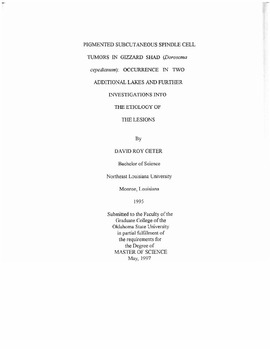| dc.description.abstract | Recently, an epizootic of pigmented subcutaneous spindle cell neoplasms was reported in a population of gizzard shad (Dorosoma cepedianum) from Lake of the Arbuckles, a man-made lake in central Oklahoma, USA (Ostrander et al. 1995; Jacobs and Ostrander, 1995). The lesions affected about 22% of adult shad, but not juveniles and the occurrence did not appear to be seasonal. The cell oforigin of the poorly differentiated neoplasms was not determined precisely. HistologicaUy it appeared to be neural, being either a pigment ceU, probably the melanophore, or a nerve sheath cell. Studies aimed at the identification of an etiological agent such as a chemical carcinogen or a retrovirus were unsuccessful. Cases of poorly differentiated neoplasms have occurred in other species from that lake. A lesion diagnosed as a hemangiopericytoma was reported from a white bass (Morone chrysops) (Hawkins et a1. 1996) and two threadfin shad (Dorosoma petenense) were recently captured and diagnosed with lesions similar to those of the gizzard shad (Geter et al. in prep.). The major objectives of the present study were to determine: (1) if lesions similar to those in Lake ofthe Arbuckles gizzard shad occurred in gizzard shad from nearby lakes; (2) if carcinogenic elements, detectable by inductively coupled plasma-mass spectroscopy (ICP-MS), could be identified in sediment, water, or fish tissues; (3) whether naturaUy occurring uranium deposits could be contributing significant radioactivity to the study sites; (4) examine genetic markers produced by RAPD and DSpeR for possible banding differences between tumor-bearing and nontumor-bearing gizzard shad; and (5) whether tumor location on the fish could be used to suggested a cause for the lesions. This thesis has been prepared as one chapter that has been submitted as a manuscript. This manuscript was submitted with collaborators to Environmental Toxicology and Chemistry. | |
